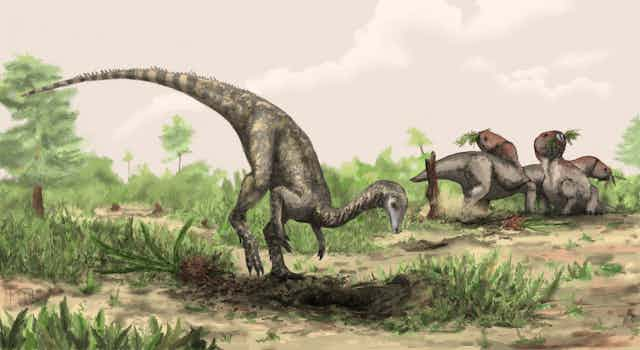Before this week, palaeontologists believed the earliest known dinosaurs were small bipedal creatures that lived 230 million years ago in South America.
This “oldest known dinosaur” floor proved quite hard to break – intense efforts to find earlier dinosaurs proved largely fruitless, the evidence consisting of inconclusive bones or fossilised footprints.
But now, in a paper published in Biology Letters, Sterling Nesbitt from the University of Washington and colleagues appear to have robustly identified 240 million-year-old Tanzanian fossils as dinosaurian. In this way, they’ve identified the oldest-ever dinosaur and added 10 million years to the age of dinosaurs.
The chosen name of this newly discovered species, Nyasasaurus parringtoni, honours the fact that the fossils were discovered in the 1930s near Lake Nyasa (now Lake Malawi) by influential Cambridge palaeontologist Rex Parrington.
The fossils only consist of an upper-arm bone (humerus) and several backbone elements (vertebrae), but they enable palaeontologists to reconstruct a reptile the size of a large dog that was either a true dinosaur, or very close relative.
Standing apart
Dinosaurs differ from other reptiles in two important respects: they stood upright on vertical legs, and they had fast growth and metabolic rates.
The dinosaur-like shape of the few known bones in Nyasasaurus suggests it too had an upright gait, although pelvic and hindlimb elements would provide more conclusive proof.
Most reptiles are slow-growing and have limb bones that exhibit concentric rings in cross-section (like tree-trunks). In contrast, dinosaurs are fast-growing and have limb bones with uniformly spongy centres.
The humerus of Nyasasaurus resembles a dinosaur bone internally, suggesting that Nyasasaurus had rapid dinosaurian growth rates.
Continental shift
When dinosaurs first appeared (approximately 230 million years ago), all the landmasses were united into the single supercontinent Pangaea. About 175 million years ago, the giant landmass began to split into Gondwanaland (south) and Laurasia (north), before gradually fracturing into the continents we see today.
The earliest dinosaurs all hail from South America or southern Africa, from localities which were then positioned on the southern side of Pangaea. This suggests dinosaurs first evolved in southern Pangaea before eventually spreading across the entire supercontinent, and all its eventual fragments.
But the rise of the dinosaurs was a more complex, extended and probably haphazard process than previously thought. For many years, scientists thought that the evolutionary innovations of dinosaurs (such as upright gait and faster growth rates) paved the way for them to rapidly outcompete their more primitive neighbours (including mammal-like reptiles).
Bob Bakker’s influential book The Dinosaur Heresies forcefully argued this view of rapid dinosaurian superiority.
That view was subsequently challenged by certain palaeontologists, who noted dinosaurs were far from an instant evolutionary success.
Rather, despite their anatomical and physiological innovations, dinosaurs took perhaps 50 million years to dominate the earth.
Rise and fall
Nyasasaurus pushes the appearance of dinosaurs back another 10 million years, further extending the lengthy lag between the evolutionary origin of dinosaurs, and became the dominant large animals in all terrestrial ecosystems.
This slow ascendancy was helped by two mass extinctions near the end of the Triassic, which left early, primitive dinosaurs relatively unscathed but decimated many of their key competitors.
Ironically, the 150 million-year reign of the dinosaurs dramatically ended by mass extinction (about 65 million years ago), courtesy of a massive meteorite impact which paved the way for mammalian dominance.
The great die-offs in the geological past have therefore often diverted evolution into entirely new and unpredictable trajectories. Current anthropogenic extinctions are likely to have similarly profound and unforeseen effects.
The new fossils show that dinosaurs were around for a lengthy period before mass extinctions facilitated their rise; the current biodiversity crisis might likewise make winners out of organisms which have until now been marginal inhabitants of our planet.

